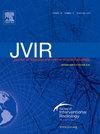在冷冻消融过程中将肠道纳入冰球:不良事件的单中心回顾性研究。
IF 2.6
3区 医学
Q2 PERIPHERAL VASCULAR DISEASE
Journal of Vascular and Interventional Radiology
Pub Date : 2025-02-01
DOI:10.1016/j.jvir.2024.09.028
引用次数: 0
摘要
材料和方法:对 2012 年 1 月 1 日至 2023 年 1 月 2 日期间接受 50 次冷冻消融术的 43 例患者进行了回顾性研究,并与接受冷冻消融术而未累及肠道的对照组(n=86)进行了比较。不良事件(AEs)按照2017年介入放射学会不良事件分类系统(1)进行分层。对12个月内发生的不良事件以及可能影响不良事件发生率的因素(如肠道受累程度和肠道受累部分)进行了回顾:13名患者发生了14起不良反应(13/43,30.2%)。其中包括 1 级 7 例(7/43,16.3%)、2 级 3 例(3/43,7.0%)和 3 级 4 例(4/43,9.3%)。其中 1 例 3 级 AE 被判定与肠道受累有关(1/43,2.3%)。按肠壁受累程度比较AEs时,全厚肠壁病例(6/9,66.7%)与部分厚肠壁病例相比受伤更多,但结果无统计学意义(P=0.140)。根据受累肠道的不同部分观察AEs时发现,胃、小肠或大肠受累的AEs分别为7例(7/14,50%)、10例(10/17,58.8%)和4例(4/19,21.1%,P=0.055)。研究组和对照组的AEs(13/43,30.2% vs 31/86,36%,p=0.511)或严重AEs(4/43,9.3% vs 9/86,10.5%,p=0.836)无明显差异:结论:这一单中心回顾性研究结果表明,冷冻消融过程中冰球累及肠壁导致肠道相关损伤的不良事件发生率低于预期。本文章由计算机程序翻译,如有差异,请以英文原文为准。

Including the Hollow Viscera (Stomach or Bowel) within the Ice Ball during Cryoablation: A Review of Adverse Events
Purpose
To evaluate the safety of including hollow viscus (stomach or bowel) in the ice ball during cryoablation.
Materials and Methods
Forty-three patients who underwent 50 cryoablations between January 1, 2012, and February 1, 2023, were retrospectively reviewed and compared with a control cohort of those who underwent cryoablation without hollow visceral involvement (n = 86). Adverse events (AEs) were stratified by the Society of Interventional Radiology (SIR) AE classification system, 2017. AEs occurring within 12 months and factors that may affect the AE rate, such as degree of hollow visceral involvement and segment of gastrointestinal tract involved, were reviewed.
Results
Fourteen AEs occurred in 13 patients (13/43, 30.2%). This included 7 Grade 1 (7/43, 16.3%), 3 Grade 2 (3/43, 7.0%), and 4 Grade 3 (4/43, 9.3%) AEs. Of them, 1 Grade 3 AE was judged to be related to bowel involvement (1/43, 2.3%). When comparing AEs by degree of visceral wall involvement, there were more injuries with the full-thickness visceral wall cases (6/9, 66.7%) than with partial-thickness visceral wall cases, but the findings were not statistically significant (P = .140). When investigating AEs by segment of the gastrointestinal tract involved, 7 (7/14, 50%), 10 (10/17, 58.8%), and 4 (4/19, 21.1%, P = .055) were found when the stomach, small bowel, and large bowel were involved, respectively. No significant differences in AEs (13/43, 30.2%, vs 31/86, 36%; P = .511) or severe AEs (4/43, 9.3%, vs 9/86, 10.5%; P = .836) were found between the study and control cohorts.
Conclusions
Findings from this single-center retrospective experience suggest that hollow visceral wall involvement by the ice ball during cryoablation resulted in a lower-than-expected rate of AEs for bowel-related injuries.
求助全文
通过发布文献求助,成功后即可免费获取论文全文。
去求助
来源期刊
CiteScore
4.30
自引率
10.30%
发文量
942
审稿时长
90 days
期刊介绍:
JVIR, published continuously since 1990, is an international, monthly peer-reviewed interventional radiology journal. As the official journal of the Society of Interventional Radiology, JVIR is the peer-reviewed journal of choice for interventional radiologists, radiologists, cardiologists, vascular surgeons, neurosurgeons, and other clinicians who seek current and reliable information on every aspect of vascular and interventional radiology. Each issue of JVIR covers critical and cutting-edge medical minimally invasive, clinical, basic research, radiological, pathological, and socioeconomic issues of importance to the field.

 求助内容:
求助内容: 应助结果提醒方式:
应助结果提醒方式:


